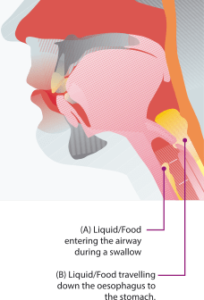This article is part 2 of 4-part series on dysphagia.
Each medical condition that causes dysphagia can affect different phases of the swallow.
Treatment advice may vary, according to the part of the swallow which is affected. It is important to visit your medical practitioner if you are having difficulty with any part of chewing or swallowing. Your GP will carry out an initial assessment and may refer you to another healthcare professional for tests.
Your GP will want to know:
- how long you’ve had signs of dysphagia
- whether your symptoms come and go or are getting worse
- whether dysphagia has affected your ability to swallow solids, liquids or both
- whether you’ve lost weight
After an initial assessment, you may be referred to:
- a speech and language therapist (SLT),
- a neurologist,
- a gastroenterologist,
- a geriatrician or,
- an ear nose and throat (ENT) specialist.
You can find in-depth details of different tests and treatment on the UK NHS website: www.nhs.uk/Conditions/Dysphagia
Swallow test
A swallow test is usually carried out by a speech and language therapist (SLT) and can give a good initial assessment of your swallowing abilities.
The SLT will ask you to swallow some water. The time it takes you to drink the water and the number of swallows required, will be recorded. You will also be asked to chew and swallow a soft piece of pudding or fruit so the SLT can look at how well your lips, tongue and the muscles in your throat work.
Video fluoroscopy
To examine your swallow in detail you may be referred for a video fluoroscopy swallowing assessment. This is like a live video x-ray which is recorded. You may be asked to swallow food and liquids of different thicknesses. The food and liquid contain barium which will show up on the video x-ray. The video can be viewed to see exactly how your swallow works.
Sometimes food or liquid travels the wrong way, into the airway, this is because the epiglottis has not closed in time. This is known as aspiration.
Aspiration
Food or liquid entering the airway is known as aspiration.
This would normally make a person cough involuntarily; a cough is one of the protective mechanisms of the lungs. Some medical conditions can weaken the strength of this cough mechanism. If food or liquid enters the lungs and cannot be coughed up it can lead to a chest infection.
The image on the right shows what happens: Arrow(A) points to liquid which is aspirating and entering the patient’s airway. All of the fluid should be travelling down the oesophagus (arrow B) into the stomach, this person has dysphagia.
Click here to read part 3 of this series – ‘Dysphagia – The Importance of Hydration’.







